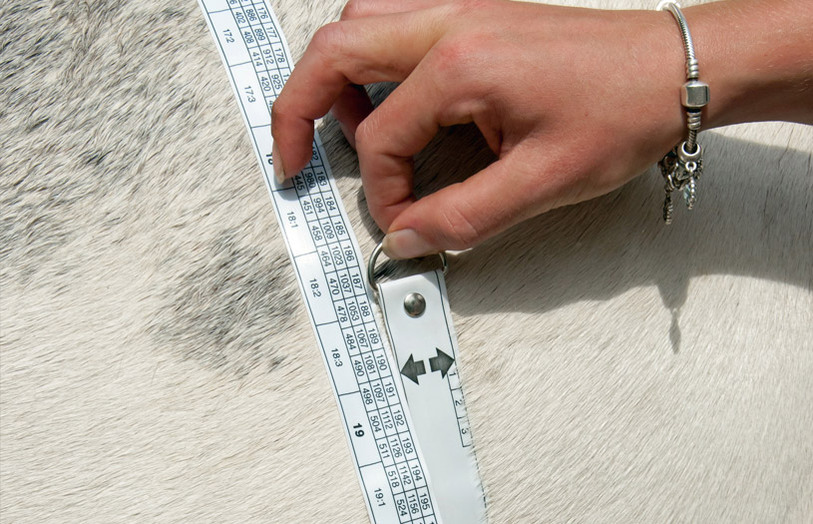
What Should Your Horse Weigh?
Equestrian Advice & Guides Beginners Advice
Build your business profile for FREE and expose your services to thousands of potential clients!
Create my profile now!
The weight of a horse will vary drastically based on a number of important factors, including the breed (or type), age and height of the horse. Their huge range in size – from miniature horses, all the way up to shire horses – makes it difficult to give an accurate average weight, even for any one breed. For example, a 9hh pony should weigh around 200kg, whereas a 16hh Draught horse can weigh in excess of 850kg.
The purpose of a horse will also naturally affect the desired weight. A Thoroughbred horse that’s primarily used for racing would be expected to weigh in at around 500kg (1,100lbs) on average, ranging from about 400kg (900lbs) for a 15hh horse to roughly 600kg (1,300lbs) for a 16.3hh horse.
To gain a better understanding of the desired weight of a horse, take a look at the following table showing the optimum weight for different types of horse, depending on height.

Please note: This table is purely for guidance purposes and should not be relied on as an accurate method for establishing the desired weight of your own horse.
No matter the breed of your horse, it’s vital that their weight stays within a healthy weight bracket, in order to prevent them from developing some potentially serious health issues. While weight loss is a problem often associated with older horses, an underweight horse can be a sign that you’re simply feeding too little and you may need to adjust their diet. For guidance on how much you should be feeding per weight, see ‘The Basics Of Equine Nutrition - Feed Levels, Nutrient Requirements & Diet Change’. For advice on feeding your golden oldie, as well as other tips on care, see ‘Caring For Your Veteran Horse Or Pony’.
Weight loss can also indicate any number of health conditions, ranging from dental problems or obstructions of the throat that are stopping the horse from chewing or swallowing properly, to conditions that create issues with maldigestion or malabsorption, like internal parasites or Inflammatory Bowel Disease (IBD). Any disease that affects the horse is likely to increase protein and energy requirements, which – if the disease is left untreated and the diet isn’t addressed – will often result in weight loss. To help catch any of these issues early, your horse should have regular dental checkups, be on a structured worming plan, and you should always seek advice about weight loss symptoms from your vet.
Obesity in horses is a more common problem, which not only impacts the horse’s fitness levels but can lead to a resistance to insulin and increase the chance of laminitis, often leading to euthanasia. This too can, of course, be due to overfeeding and if you have a good doer, overconsumption can be hard to avoid. For advice on limiting forage intake, see ‘The Pros And Cons Of Grazing Muzzles’.
For these reasons, it is essential that you keep a regular record of your horse’s weight throughout the year to keep track of any gains or losses.
There are several ways to calculate the weight of your horse, some more accurate than others.
Getting an accurate reading of your horse’s weight is essential when calculating dosages of medical treatment or suchlike, and a rough estimate should never be relied on in these circumstances.
By far the most accurate way of determining your horse’s weight is by using an equine-specific weighbridge, which is exactly the same concept as us using bathroom scales to find our own weight! Most veterinary practices will have a weighbridge you can use and plenty of equestrian professionals provide mobile weighing services with a portable set of equine scales. You can also hire or even purchase a weighbridge yourself, which, if you own more than one horse, might be a sensible investment for the long term.

You can find out more about the different types of weighbridge available by visiting the Horse Weigh website, the leading manufacturer of horse weighing platforms.
While for medical purposes it’s incredibly important to get the most accurate reading possible, when it comes to simply monitoring fluctuations in your horse’s weight, an alternative method of finding their weight can be just as useful – as long as you know how best to calculate it and roughly how much the estimate is likely to be out by.
The most basic analysis of a horse’s body condition is usually made simply by feel and visual observation – know as fat scoring or Body Condition Scoring (BCS) – with most people describing their horse as either too thin, in good flesh or obese. There are a number of signs you can look out for that will help you gauge whether they are within their desired weight bracket, such as ribs showing or fatty deposits. You should be able to feel the ribs on a healthy horse but not see them.

The BHS (British Horse Society) has some great advice on ‘How to fat score your horse’ with details on how to assess each part of the body.
For information on identifying equine obesity, see ‘Obesity In Horses - How To Tell If Your Horse Is Overweight & Help Them Lose The Pounds!’
Visual assessment is a good way to keep an eye on your horse from day to day, however, a more accurate measurement – even if still an estimate – should be taken at regular intervals throughout the year.
If your horse’s body type fits into the ‘standard’ ratio of weight to height, you can get a good estimate of your horse’s weight using an equine weight tape. A weight tape is marked in pounds or kilograms, rather than in centimetres and inches, and can easily be purchased online (or ask your feed supplier).
 It’s worth noting that a weight tape generally gives a less accurate calculation than using a regular tape measure and a formula (see below) and can be out by as much as 100-200lbs (45-90kg), but it can be more convenient as it’s easier to do with just one person.
It’s worth noting that a weight tape generally gives a less accurate calculation than using a regular tape measure and a formula (see below) and can be out by as much as 100-200lbs (45-90kg), but it can be more convenient as it’s easier to do with just one person.
Tips for using a weight tape;
1. Your horse should be stood on level ground when you take the measurement
2. In order to get a more accurate measurement, both you and your horse should be relaxed
How to use an equine weight tape;
1. Stand on one side of the horse and lie the weight tape flat over the horse’s back so it sits just behind the withers keeping the ‘zero’ end of the tape on your side of the horse
2. Grab the other end of the tape under their body and hold it where the girth would go – just behind the elbows – bring it back up round to your side and pull the tape snug (not tight) against the horse
3. Read the number on the weight tape where it meets the ‘zero’ end of the tape and that’s the amount your horse weighs according to this calculation.
As mentioned above, there is a formula you can use – with the help of a regular tape measure – that will provide a slightly more accurate estimate of your horse’s weight than using a designated equine weight tape. Just follow these steps;
 1. Measure your horse’s heart girth – Exactly as instructed above, measure from one side of the horse, under their belly (behind the elbows), up to just behind the withers and back down over the other side to meet the zero end of the tape you started with - the tape measure should be snug but not tight around the horse.
1. Measure your horse’s heart girth – Exactly as instructed above, measure from one side of the horse, under their belly (behind the elbows), up to just behind the withers and back down over the other side to meet the zero end of the tape you started with - the tape measure should be snug but not tight around the horse.
2. Record the result – Write down the number shown on the tape and make sure to note whether you measured in centimetres or inches (we’ll need this in a minute!)
3. Measure your horse’s length – Depending on the size of your horse, you’ll likely need a helping hand for this one! Ask someone to hold the tape measure with the ‘zero’ end touching the point of the horse’s shoulder. Walk down the side of your horse, gently pulling the tape measure until you reach the point of the horse’s buttock - pull it taught to this point and read the measurement, again in the same format as you measured the heart girth (cm/in). Note this down.
Repeat steps 1 to 3 a few times for a more accurate measurement.
4. Do the maths! – So now you need to use the measurements you’ve taken to do one of the following two calculations; which one depends on whether you measured in centimetres or inches.
If you measured in centimetres, the calculation is…
If you measured in inches, the calculation is…
So, in summary, there are a number of ways to find the average weight of your horse for the purposes of monitoring fluctuations in their size. However, if you need to know your horse’s weight in order to decide on a particular dosage of medication, a more accurate reading will need to be taken using an equine weighbridge.


